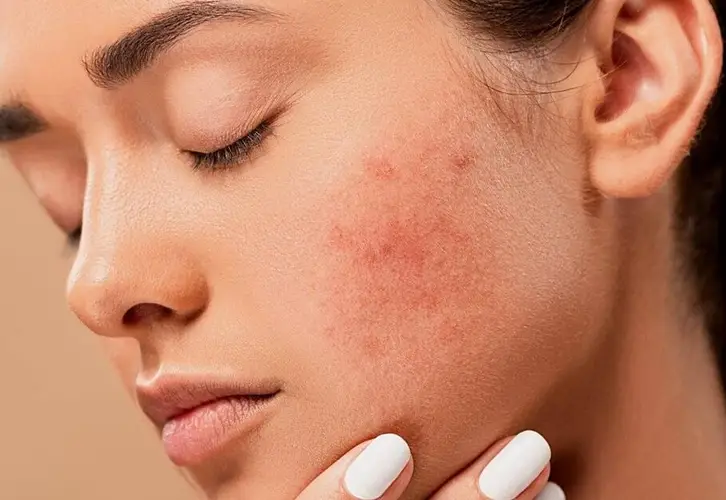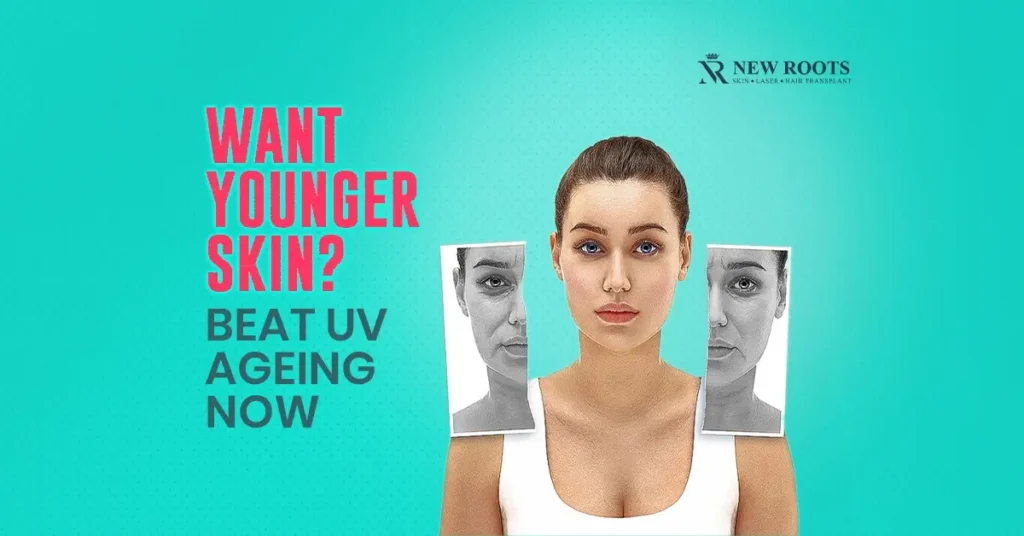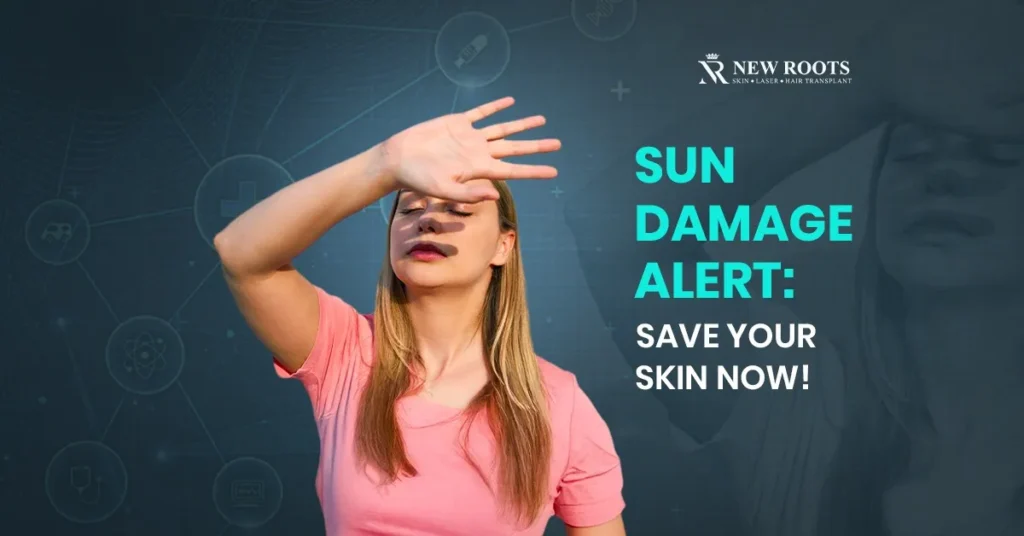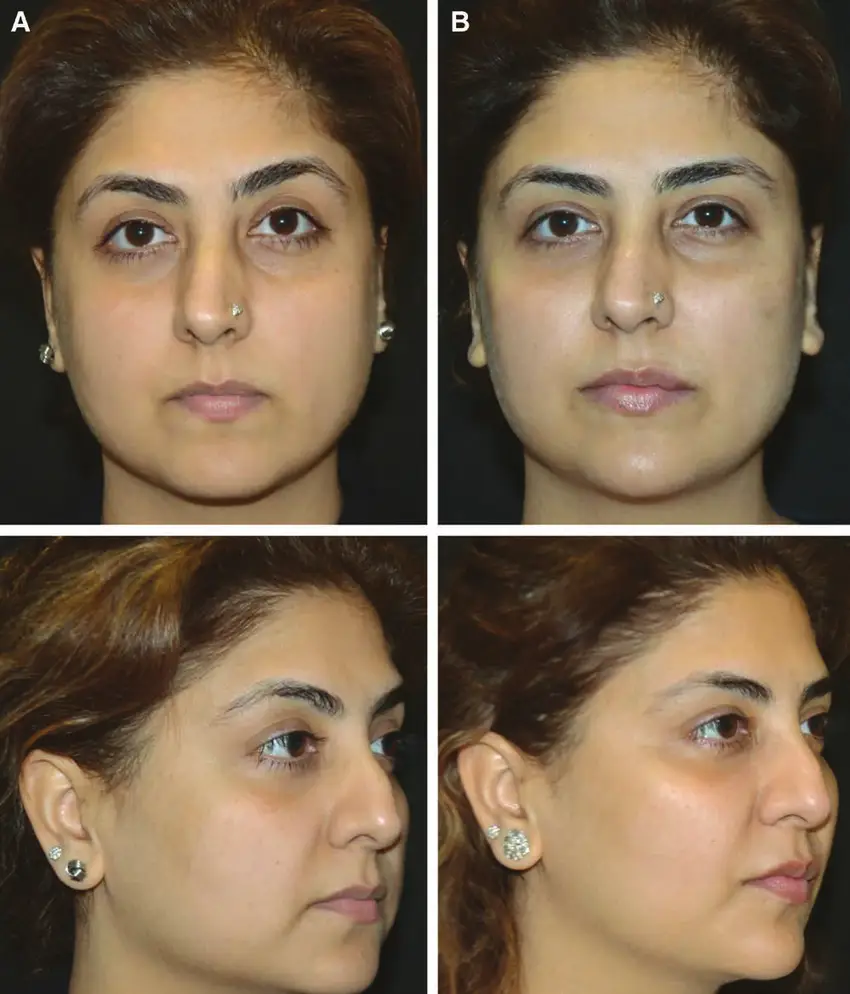Introduction
The tropical climate of Maharashtra presents a unique and persistent challenge to skin health.
With prolonged UV exposure and high humidity levels dominating most of the year, ageing skin becomes a common concern, whether you’re strolling along the beach in Mumbai, braving the semi-humid hills of Pune, or enduring the harsh, dry sunlight of Nagpur.
These environmental conditions do more than just cause temporary discomfort; they actively accelerate the ageing skin process through cumulative UV damage.
Often, we attribute premature wrinkles, dullness, and pigmentation to pollution, stress, or lack of skincare. While these factors contribute, the real and often-overlooked culprits are the combined effects of UV radiation and moisture overload.
These two forces silently but powerfully break down the skin barrier, weaken collagen and elastin, and trigger oxidative stress, all of which are classic hallmarks of ageing skin caused by long-term UV damage. If unaddressed, they can visibly age the skin as early as your mid-20s or 30s.
Understanding how this process works is the first step toward prevention. In this comprehensive guide, we explore:
- How Maharashtra’s varied climate, from coastal humidity to dry heat, affects your skin
- The science behind UV-induced and humidity-driven ageing
- What visible ageing looks like across different regions
- Clinical insights from leading dermatologists across the state
- Proven, dermatologist-approved strategies and natural remedies to protect, repair, and slow down the ageing process
Whether you’re just starting your skincare journey or already seeing early signs of damage, this blog will equip you with practical, climate-conscious solutions to help your skin age gracefully even under Maharashtra’s unforgiving sun.
Table of Contents
Why Humidity and UV Accelerate Ageing
👉 1. Collagen Breakdown Due to UV Rays
Maharashtra experiences high UV indices (often >8), especially from March to June.
- UV-A rays penetrate deep into the dermis, breaking down collagen and elastin, leading to sagging and wrinkles.
- UV-B rays damage the outer skin (epidermis), causing sunburns and DNA mutations, accelerating aging signs.
Visible Outcomes:
- Fine lines and wrinkles
- Uneven skin tone
- Loose skin
- Sunspots and pigmentation

👉 2. Humidity Increases Free Radical Damage
In cities like Mumbai and Raigad:
- High humidity keeps pores open, exposing skin to microbes and pollutants.
- Excess sweat and moisture lead to oxidative stress and “inflammageing”—skin ageing triggered by chronic inflammation.
- Higher sebum production clogs pores, worsening acne and post-acne scarring.
👉 3. Sweat and Salt Cause Barrier Dysfunction
- Sweat depletes minerals like zinc and magnesium, essential for skin repair.
- Salt irritates the skin barrier, increasing UV and pollutant permeability.
- Skincare product effectiveness, including sunscreen, is reduced on compromised skin.
👉 4. Dehydration from Heat Stress
Even oily skin can be dehydrated inside due to:
- Increased trans-epidermal water loss (TEWL)
- Resulting in dullness, deep lines, and reduced skin plumpness
Weather Conditions in Maharashtra & Skin Ageing Risks
Maharashtra’s diverse geography creates a wide range of microclimates from the humid coastal belt of Mumbai to the arid interiors of Aurangabad and the semi-humid plateau of Pune.
Each region presents unique challenges for skin health and contributes differently to the progression of ageing skin.
The UV index remains consistently high across the state, while humidity levels vary drastically, both of which are major accelerators of UV damage and premature skin ageing.
Understanding how your local climate influences ageing skin and triggers UV damage is key to prevention and treatment.
The table below outlines major cities in Maharashtra, highlighting their average UV exposure, humidity levels, and the corresponding risk of ageing skin due to environmental stressors.
| Region | Climate Type | UV Index (Avg.) | Humidity (%) | Ageing Risk |
| Mumbai | Coastal, humid | 8–11 (Very High) | 70–90% | Very High |
| Pune | Semi-humid plateau | 7–9 | 50–70% | High |
| Nagpur | Hot & dry | 9–11 (Peak) | 30–40% | High |
| Nashik | Hilly & dry | 7–8 | 40–60% | Moderate |
| Aurangabad | Arid interior | 8–10 | 30–50% | High |
What Skin Ageing Looks Like in Maharashtra
Skin ageing in Maharashtra isn’t a one-size-fits-all picture; it varies based on where you live and how much sun, humidity, and pollution your skin faces daily.
From the sun-exposed dry plains of Nagpur to the sweat-soaked streets of Mumbai, the environmental backdrop shapes how and when signs of ageing appear.
Constant UV exposure and humidity-related barrier damage result in visible concerns like wrinkles, pigmentation, dullness, and uneven skin tone, sometimes as early as your 20s.
The table below breaks down how different ageing symptoms are triggered by UV rays or humidity, and how they manifest across various regions of Maharashtra.
| Skin Concern | Caused by UV | Caused by Humidity | Observed in Maharashtra |
| Wrinkles | Yes | Indirectly | Urban & rural areas |
| Sagging | Yes | No | Common over 40 |
| Pigmentation | Yes | Yes | All skin tones |
| Dull Skin | Yes | Yes | Especially in summer |
| Uneven Tone | Yes | Yes | High prevalence |
| Acne-induced Scars | No | Yes | Coastal & semi-humid zones |
The Science of Skin Ageing: Tropical Accelerators
👉 1. Photoageing vs Chronological Ageing
- Chronological ageing: Genetically programmed, slow, and visible in your 40s–50s.
- Photoageing: Sun-induced and aggressive; shows up in your 20s–30s as pigmentation, roughness, sunspots, and uneven tone.
👉 2. The Role of Melanin in Indian Skin
Indian skin (Fitzpatrick Type III–V) contains more melanin, which provides some UV protection, but:
- Increases the risk of hyperpigmentation and sunspots
- Delays the healing of acne and UV damage
- Prone to post-inflammatory hyperpigmentation (PIH), especially with humidity-driven breakouts
Clinical Observations from Maharashtra
Across Maharashtra, dermatologists are witnessing a clear and growing trend: premature ageing skin is no longer a concern limited to those over 40.
Environmental factors such as intense UV exposure, persistently high humidity, pollution, and heat stress are accelerating the breakdown of collagen and elastin, leading to visible ageing skin concerns like fine lines, wrinkles, and pigmentation even in individuals in their late 20s and early 30s.
Urban and semi-urban populations, especially in cities like Mumbai, Pune, and Nagpur, are increasingly presenting with early signs of UV damage.
The combined effect of UV damage and moisture imbalance in the atmosphere plays a pivotal role in weakening the skin barrier and triggering long-term skin ageing.
👉 Key Clinical Patterns Reported by Dermatologists:
- Over 70% of middle-aged patients (aged 35–50) in cities like Mumbai, Pune, and Thane show visible signs of photoageing—including fine lines, pigmentation, sunspots, dullness, and skin laxity. Long-term sun exposure and daily commutes in open or semi-shaded conditions contribute significantly to this early damage.
- Young adults aged 25–35 in Nagpur and Aurangabad are increasingly presenting with freckles, melasma, and early pigmentation, often driven by intense UV-B exposure, coupled with stress and hormonal changes. Many of these individuals have outdoor professions or travel long distances without adequate sun protection.
- Mumbai, due to its high humidity, salt air, and reflective UV bounce from sea, glass buildings, and light-colored pavements, sees some of the most complex ageing presentations. Dermatologists here commonly observe “acne-ageing overlap”, where patients deal with both active acne and signs of skin ageing, such as post-inflammatory hyperpigmentation (PIH), rough texture, and fine lines.
- PIH and persistent acne scars are particularly difficult to treat in such humid climates, as sweat and sebum continue to aggravate inflammation. These conditions worsen without regular SPF use and proper barrier repair routines.
- A noticeable rise in anti-ageing consultations under the age of 30 is being reported. Dermatology clinics in Pune, Nagpur, and Mumbai confirm that more young patients now proactively seek treatments such as chemical peels, antioxidant-rich serums, SPF-based skincare, and even early laser treatments or microneedling to prevent long-term damage.
- Environmental exposure is also leading to asymmetrical ageing patterns, especially among those in outdoor jobs—delivery personnel, drivers, street vendors, and farmers. This is commonly referred to as “driver’s face”, where one side of the face appears older due to prolonged sun exposure through vehicle windows.
How to Prevent UV and Humidity-Induced Skin Ageing
Daily Skincare Routine for Maharashtra
| Step | Product Type | Purpose |
| Cleanser | Gentle, non-drying foaming | Removes sweat & oil |
| Toner | Alcohol-free, pH-balancing | Soothes and reduces inflammation |
| Serum | Vitamin C, Niacinamide | Brightens, fades pigmentation |
| Moisturizer | Gel-based, Hyaluronic Acid | Hydrates without clogging pores |
| Sunscreen | Broad-spectrum SPF 50+, sweatproof | Shields against UV-A and UV-B rays |
Reapply sunscreen every 3–4 hours if outdoors. Avoid peak UV hours (11 AM – 3 PM).
Dermatological Treatments Available in Maharashtra
For those struggling with stubborn signs of UV-induced ageing like sunspots, wrinkles, uneven tone, or post-acne pigmentation, professional dermatological treatments can offer faster, targeted results.
In Maharashtra’s diverse climate zones, from humid coastal cities to dry inland regions, expert skin clinics provide advanced therapies specifically designed to combat UV damage and ageing skin.
These treatments not only help reverse visible UV damage but also stimulate collagen production, tighten skin, and restore clarity.
Whether you’re looking to reduce pigmentation, smooth fine lines, or strengthen your skin barrier, these in-clinic solutions are guided by dermatologists who understand how ageing skin reacts under constant tropical UV exposure.
With personalized care, even long-standing signs of UV-induced ageing can be effectively addressed.
👉 Effective Therapies:
- Chemical Peels – Remove sun-damaged layers
- Microneedling + PRP – Boosts collagen
- Laser Toning – Evens out sunspots
- Botox – Smoothens dynamic wrinkles
- Hydrafacial – Deep hydration, ideal for humid zones
Natural Remedies for Daily Skin Repair
When it comes to combating UV damage and ageing skin, sometimes the most effective solutions are rooted in tradition.
In Maharashtra’s tropical climate, where harsh sun and humidity are daily concerns, natural remedies offer gentle yet powerful support for everyday skin repair.
These ingredients—often found in Indian kitchens—help soothe inflammation, reduce pigmentation, and restore skin balance without the side effects of harsh chemicals.
Whether you’re dealing with sun-induced dullness, breakouts, or early signs of ageing, these time-tested remedies can complement your skincare routine and support long-term skin health.
| Remedy | Purpose |
| Kesar + Milk | Tan removal, texture improvement |
| Aloe Vera Gel | Soothes sunburns, hydrates |
| Multani Mitti | Controls oil, acne, and cools the skin |
| Coconut Water | Detoxifies, hydrates from within |
| Sandalwood Paste | Reduces pigmentation and inflammation |
| Cucumber Juice | Calms puffiness, heat rash |
| Honey + Lemon (night only) | Mild exfoliation, antibacterial |
| Besan + Yogurt | Tan removal, exfoliates dead skin |
| Turmeric + Malai | Nourishing for dry, sun-damaged skin |
Patch test before use. Avoid citrus and turmeric during the day to prevent photosensitivity.
Build Skin Resilience with Diet
Your diet plays a powerful role in how your skin defends itself against UV damage and environmental ageing.
While external care like sunscreen and moisturizers forms your first line of defense, internal nourishment is what strengthens your skin from within.
Nutrients that support collagen synthesis, fight oxidative stress, and promote skin repair are essential for slowing down the signs of premature ageing, especially in UV-intensive, humid climates like Maharashtra.
Here’s a list of key nutrients that help build long-term skin resilience:
| Nutrient | Function | Sources |
| Vitamin C | Collagen production | Amla, oranges, guava |
| Vitamin E | UV damage repair | Almonds, sunflower seeds |
| Omega-3 | Anti-inflammatory | Flaxseeds, fish, and walnuts |
| Zinc | Skin healing | Pumpkin seeds, legumes |
| Water | Hydration and detox | 2.5–3L daily |
Conclusion
In Maharashtra’s sun-drenched, humid climate, ageing skin accelerates fast if you’re not proactive.
Prolonged exposure to high UV damage levels combined with sticky moisture weakens collagen and leads to premature fine lines, especially in exposed areas.
Whether it’s premature wrinkles in Nagpur or post-acne pigmentation in Mumbai, your skincare must adapt to the environment.
Daily sun protection, antioxidant-rich products, and targeted hydration are essential to prevent further UV damage and slow the visible signs of ageing skin.
In regions with intense sunlight, like Aurangabad or Nashik, reinforcing your skin barrier becomes non-negotiable.
- Start with a high-SPF sunscreen
- Stay hydrated—internally and topically
- Add antioxidants (Vitamin C, E)
- Treat visible damage with dermatologist guidance
Consistency is your best defence. Build a climate-conscious skincare routine today and age gracefully, not prematurely. For expert dermatological care and customized treatments, visit New Roots – Skin, Laser & Hair Transplant Clinic.
When shedding persists or becomes worse, they should contact a hair specialist. As we know, immediate measures can help a lot to avoid further damage.
By taking your time, being patient and consistent, and being careful, you will eventually get your hair back in control and start to control the shedding. Hold it together by supporting your hair will regain.
Q&A ASK
High UV and humidity cause collagen breakdown, barrier damage, and oxidative stress, triggering early wrinkles, pigmentation, and dullness—even before 40.
Yes. UV-A rays penetrate clouds and glass. Use SPF 50+ daily, reapplying every 3–4 hours, rain or shine.
Use gentle cleansers, non-comedogenic products, and include niacinamide or azelaic acid. Daily sunscreen prevents PIH from darkening.
Yes, but use cautiously. Avoid lemon juice and turmeric during the day to prevent photosensitivity.
Chemical peels, microneedling with PRP, laser toning, and Hydrafacials are effective for UV-related ageing. Consult a certified dermatologist near you.






